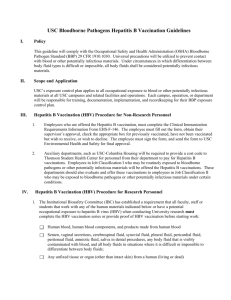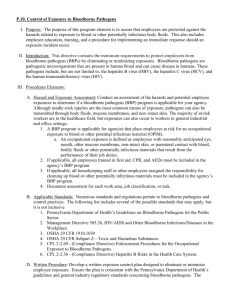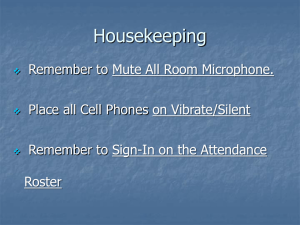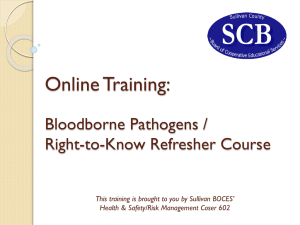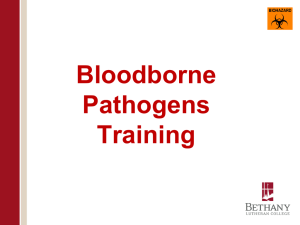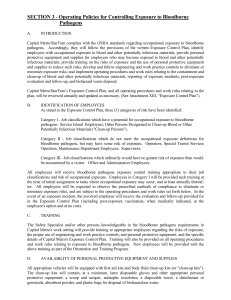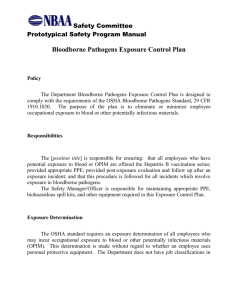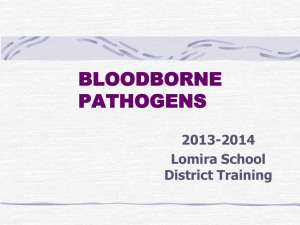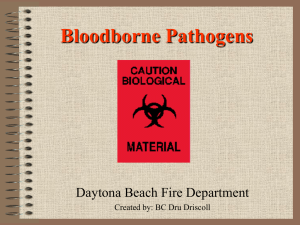bbp
advertisement
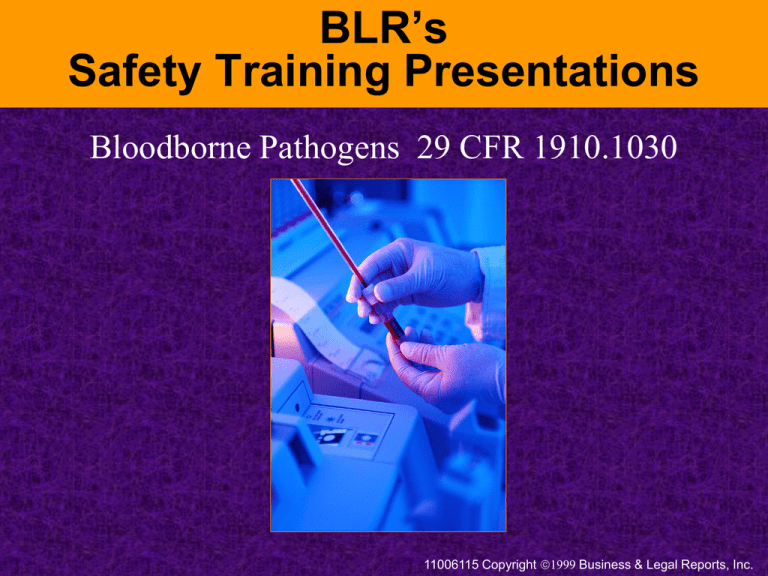
BLR’s Safety Training Presentations Bloodborne Pathogens 29 CFR 1910.1030 11006115 Copyright Business & Legal Reports, Inc. Regulatory Requirements OSHA Standard 29 CFR 1910.1030 Covers all employers who require employees to perform duties that may expose them to bloodborne pathogens Requires a written exposure control plan (ECP) Requires specific training Requires specific recordkeeping 11006115 Copyright Business & Legal Reports, Inc. Bloodborne Pathogens “Pathogenic microorganisms that are present in human blood and can cause disease in humans.” 11006115 Copyright Business & Legal Reports, Inc. Pathogens of Primary Concern Hepatitis B Virus (HBV) Human Immune Deficiency Virus (HIV) 11006115 Copyright Business & Legal Reports, Inc. Ways to Reduce the Risk Engineering or work practice controls Use of personal protective equipment Training Medical surveillance Hepatitis B vaccinations Signs and labels 11006115 Copyright Business & Legal Reports, Inc. Definition of ‘Occupational Exposure’ “A reasonably anticipated skin, eye, mucous membrane or parenteral contact with blood or other potentially infectious material (OPIM) that may result from the performance of an employee’s duties” 11006115 Copyright Business & Legal Reports, Inc. Definition of ‘Exposure Incident’ “A specific eye, mouth, or other mucous membrane, non-intact skin, or parenteral contact with blood or other potentially infectious materials that results from the performance of an employee’s duties.” 11006115 Copyright Business & Legal Reports, Inc. Examples of Infectious Body Materials Blood Semen Vaginal Secretions Cerebrospinal Fluid Synovial Fluid Pleural Fluid Unfixed skin or tissue (living or dead) 11006115 Copyright Business & Legal Reports, Inc. Examples of Infectious Body Materials (cont.) Pericardial fluid Peritoneal fluid Amniotic fluid Saliva Cell or tissue cultures 11006115 Copyright Business & Legal Reports, Inc. Rules to Live By Always follow universal precautions: Treat all blood and body fluids as if they are contaminated! 11006115 Copyright Business & Legal Reports, Inc. Types of Facilities Covered Under the BBP Standard Health care Laboratories Medical and dental equipment service Infectious waste disposal Emergency response groups 11006115 Copyright Business & Legal Reports, Inc. Elements of an Exposure Control Plan (ECP) General statement about the program Jobs expected to incur exposure Procedures for handling infectious materials Labeling system Availability of hepatitis B vaccination 11006115 Copyright Business & Legal Reports, Inc. Elements of the ECP (cont.) Exposure records Training records Name of responsible person 11006115 Copyright Business & Legal Reports, Inc. Regulated Waste Liquid or semi-liquid blood or OPIM (other potentially infectious materials) Contaminated items that would release blood or OPIM when compressed Items caked with dried blood or OPIM that are capable of releasing such Contaminated sharps Pathological and microbiological waste containing blood or OPIM 11006115 Copyright Business & Legal Reports, Inc. Hepatitis B Vaccination Must be offered to all occupationally exposed employees Must be offered within 10 days of initial assignment Post-exposure evaluation and follow-up must be offered after exposure incident Must be provided at no cost to employees 11006115 Copyright Business & Legal Reports, Inc. Communication of Hazards Signs Labels Training 11006115 Copyright Business & Legal Reports, Inc. Label Requirements Attached to containers of waste Attached to refrigerators or freezers containing blood or OPIM Attached to containers used to store transport, or ship blood or OPIM Labels must include universal biohazard symbol and the term “Biohazard” 11006115 Copyright Business & Legal Reports, Inc. Recordkeeping Two types of records –Medical –Training Medical records must include: –Employee name and SSN –Hepatitis B vaccination status –Post-exposure evaluation and follow-up results –Health care professional’s written opinion –Health care specific information 11006115 Copyright Business & Legal Reports, Inc. Recordkeeping (cont.) Training records must include: –Training dates –Contents of the training –Name and qualifications of trainer –Name of job titles of trainee 11006115 Copyright Business & Legal Reports, Inc. Record Retention Medical records must be kept confidential Medical records must be maintained for employment plus 30 years Medical records must be available to employees upon request Medical records must be available to authorized persons (e.g., OSHA, NIOSH) 11006115 Copyright Business & Legal Reports, Inc. Record Retention (cont.) Training records must be kept for three years Medical and training records must be transferred to successor employers If no successor employer, current employer must notify the director of NIOSH 11006115 Copyright Business & Legal Reports, Inc. Quiz 1. The risk of exposure to bloodborne pathogens is only possible when blood is present in the body fluid. True or False 2. The two regulated pathogens of concern are __________________ and __________________. 3. The term OPIM refers to Obvious Probability of Infectious Material. True or False 4. Treating all body fluids as infected is known as __________________________________ precautions. 5. Hepatitis B vaccinations do not have to be offered to occupationally exposed employees. True or False 11006115 Copyright Business & Legal Reports, Inc. Quiz (cont.) 6. Three of the six ways to reduce the risk of exposure to bloodborne pathogens are _______, ______, and ______. 7. If employees are potentially exposed to bloodborne pathogens as part of heir duties, the company is required to have an exposure control plan. True or False 8. Items to be disposed of that contain potentially infectious materials must be treated as ________________________. 9. Medical records must be kept for three years past the termination of employment. True or False 10. Two types of records required to be maintained under the Bloodborne Pathogen Standard are _______ and ________ records. 11006115 Copyright Business & Legal Reports, Inc. Quiz Answers 1. True. Although many body fluids may be infectious, they must contain blood to carry bloodborne pathogens. 2. The two regulated pathogens of concern are HIV and hepatitis B. 3. False. The term OPIM refers to Other Potentially Infectious Materials. 4. Treating all body fluids as infected is known as universal precautions. 5. False. Hepatitis B vaccinations do have to be offered to those employees occupationally exposed to bloodborne pathogens. 11006115 Copyright Business & Legal Reports, Inc. Quiz Answers (cont.) 6. Three of the six ways ways to reduce the risk of exposure to bloodborne pathogens are engineering or work practice controls, PPE, training, medical surveillance, hepatitis B vaccinations, and signs and labels. 7. True. Companies with potentially exposed employees must have an exposure control plan. 8. Items to be disposed of that contain potentially infectious materials must be treated as regulated waste. 9. False. Medical records must be kept for 30 years past termination of employment. 10. Two types of records required to be kept under the Bloodborne Pathogen Standard are medical and training records. 11006115 Copyright Business & Legal Reports, Inc.
